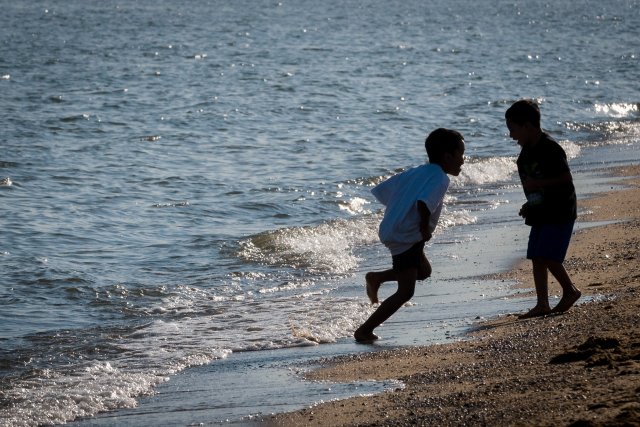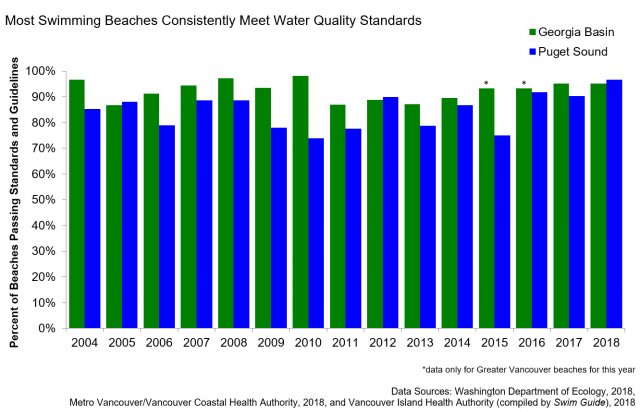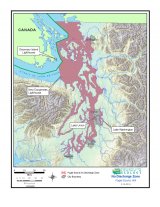Swimming Beaches
Updated June 2021 based on data available through December 2018.
- About Swimming Beaches
- What's Happening?
- Why Is It Important?
- Why Is It Happening?
- What's Being Done About It?
- Five Things You Can Do To Help
- References
About Swimming Beaches

Access to clean swimming beaches contributes to the high quality of life we enjoy in this region. The cleanliness of Salish Sea swimming beaches is an indicator of water quality, and is determined by testing the water for specific types of bacteria.
Bacteria found in human and animal feces (poop) can cause serious health problems if the levels are above water quality standards in recreational areas. Beach closures when waters are contaminated with bacteria prevent people and pets from becoming ill.
This indicator tracks the percentage of monitored swimming beaches in the Salish Sea that consistently meet water quality standards through the swimming season, which is between May and September every year.
"It is through teachings, transferred from those that hold knowledge (Elders) to those that learn and carry on the knowledge (youth), that the health and well-being of the community are preserved and upheld through the generations."
What's Happening?
Between 2004 and 2018 at least 87% of monitored swimming beaches in the Georgia Basin and at least 74% of monitored beaches in Puget Sound consistently met water quality guidelines and standards (see chart below).
In 2018, 95% of tested beaches in the Georgia Basin met Canadian water quality guidelines for recreation. The number of beaches tracked over time in the Georgia Basin has fluctuated but annual results show that most beaches consistently met the standards each year (see Table 1 below).
Two swimming beaches (out of the 61 beaches monitored) in Puget Sound and 5 out of 102 beaches in Georgia Basin exceeded water quality standards more than once through the 2018 swimming season (see Tables 1 and 2 below).
| Year | Number of Beaches that Failed Standards | Number of Beaches Sampled |
|---|---|---|
| 2004 | 1 | 30 |
| 2005 | 4 | 30 |
| 2006 | 3 | 34 |
| 2007 | 2 | 36 |
| 2008 | 1 | 37 |
| 2009 | 3 | 46 |
| 2010 | 1 | 56 |
| 2011 | 11 | 84 |
| 2012 | 11 | 98 |
| 2013 | 15 | 116 |
| 2014 | 12 | 114 |
| 2015 | 2 | 30 (Greater Vancouver only) |
| 2016 | 2 | 30 (Greater Vancouver only) |
| 2017 | 5 | 104 |
| 2018 | 5 | 102 |
| Year | Number of Beaches that Failed Standards | Number of Beaches Sampled |
|---|---|---|
| 2004 | 10 | 68 |
| 2005 | 8 | 67 |
| 2006 | 15 | 71 |
| 2007 | 7 | 62 |
| 2008 | 7 | 53 |
| 2009 | 15 | 68 |
| 2010 | 12 | 46 |
| 2011 | 17 | 76 |
| 2012 | 6 | 60 |
| 2013 | 13 | 61 |
| 2014 | 8 | 60 |
| 2015 | 16 | 64 |
| 2016 | 5 | 61 |
| 2017 | 6 | 62 |
| 2018 | 2 | 61 |
What are we actually measuring?
Fecal coliform bacteria are present in virtually all warm-blooded animals, including humans. Not all of the bacteria in the fecal coliform group can make people sick but the fecal coliform bacteria group are used as an indicators that contamination from feces is present in water. High levels of fecal coliform in the water means that illness-causing bacteria and viruses associated with animal feces (which are harder to measure) are likely present.
Escherichia coli (E. coli) represent about 97% of all the coliform bacteria in human feces, which makes them an excellent indicator of fecal contamination.
Another form of bacteria, Enterococci, survive longer than fecal coliforms in marine water. This type of bacteria is useful to measure when the source of fecal contamination is further from the swimming area. A strong correlation has been demonstrated between the concentration of Enterococci in marine waters and the risk of gastrointestinal infection.
What are the benchmarks?
Different benchmarks and indicator bacteria are used to interpret water quality data sampled from Georgia Basin and Puget Sound.
Georgia Basin
Water samples taken from swimming beaches in Georgia Basin are tested for levels of E. coli and compared to Canadian Water Quality Guidelines which require that:
- E. coli levels must not exceed 200 bacterial colonies/100mL for the average (geometric mean) of at least 5 samples, taken less than 30 days apart. In addition, no single sample can exceed 400 bacterial colonies/100 mL. These requirements are used at beaches monitored by Vancouver Coastal Health and Fraser Health.
- Beaches monitored by the Vancouver Island Health Authority have requirements based on the water type at the beach. At freshwater swimming beaches, E. coli levels must not exceed 200 bacterial colonies/100mL for the geometric mean of at least 5 samples AND a single sample should not exceed 400 colonies/100 mL. At saltwater beaches, Enterococci, is measured. The Enterococci levels must not exceed 35 bacterial colonies/100 mL for the average (geometric mean) of at least 5 samples AND a single sample should not exceed 70 colonies/100 mL.
Puget Sound
Water samples taken from saltwater swimming beaches in Puget Sound are tested for levels of the Enterococci bacteria. Samples are compared to Washington's Water Quality Standards which require that:
- Enterococci levels must not exceed a geometric mean of 30 bacterial colonies/100 mL, calculated from a minimum of 5 weekly samples and a maximum of 12 weekly samples. The statistical threshold value cannot exceed 110 colonies/100 mL, and any one sample cannot exceed 104 colonies/100 mL.
Why is it Important?
Clean swimming beaches are an important part of the quality of life in the Salish Sea region. This indicator is closely linked to local practices and management actions.
Swimming, diving, or wading in water contaminated with fecal bacteria can result in gastrointestinal illness (such as diarrhea or vomiting), respiratory illness, and other health problems. Skin, ear, eye, sinus, and wound infections can also be caused by contact with contaminated water.
Why is it Happening?
Fecal contamination at swimming beaches can be caused by many issues, including:
- Malfunctioning sewage treatment plants and discharges from combined sewers.
- Improperly maintained septic systems.
- Sewage from recreational boaters.
- Rain water runoff carrying pet and other animal waste.
- A high number of swimmers.
What's Being Done About It?
Canadian and American agencies routinely monitor Salish Sea recreational beaches during the swimming season and advise local governments or other responsible parties (e.g. BC Parks) to post beach advisories if the most recent sample results do not meet guideline limits. These agencies are also taking actions to help reduce the causes of beach closures due to high levels of bacteria.
Examples
Below are some examples of programs that are helping protect public swimming beaches and reduce causes of beach closures:
- In Puget Sound, the Beach Environmental Assessment, Communication, and Health (BEACH) Program is led by the Washington State Departments of Ecology and Health along with county and local agencies, tribes, and volunteers. The BEACH Program monitors high-risk saltwater beaches for bacteria and notifies the public when bacteria are at unhealthy levels.
- The Washington Department of Health helps support Pollution Identification and Correction (PIC) programs in 11 Puget Sound counties. This helps local jurisdictions monitor and notify the public about bacterial pollution at recreational beaches and helps support local corrective actions needed from on-site sewage systems and farms.
-
Map of Puget Sound no-discharge zone. - In Metro Vancouver, and throughout Puget Sound, construction of new combined sewer-stormwater systems is not allowed. These types of systems (also called Combined Sewer Overflows, or CSOs) can cause serious water pollution problems due to overflows during rain storms because they collect both sewage and stormwater runoff in a single pipe system. Existing combined sewers in Metro Vancouver are being monitored and replaced by separate sanitary and storm sewers through infrastructure and sewer capacity upgrading programs. Combined sewers in Puget Sound are monitored and controlled using multiple methods, including separating sewage and stormwater, building new tunnels to store overflow for later treatment, and adding green stormwater infrastructure such as rain gardens.
Learn More
The following links exit the site
- Washington Dept. of Health - Swimming Beach Advisories
- Puget Sound Partnership Vital Signs - Swimming Beaches
- Health Canada - Recreational Water
- Metro Vancouver’s Environmental Monitoring – Beaches and Recreational Waters
- Fraser Health - Beach Conditions
- Vancouver Coastal Health - Beach Water Quality Reports
- Vancouver Island Health Authority - Beach Reports
- Beaches in British Columbia – Swim Guide
- Beaches in Washington – Swim Guide
Six Things You Can Do To Help
- Do not attend or allow your children to attend a public bathing beach if they are ill, or recently have been ill, particularly if symptoms included vomiting or diarrhea. To avoid passing an illness to other people, no swimming should occur during an illness and for 48 hours after symptoms have ended.
- Scoop your pet's poop. Pet waste is full of bacteria that can get washed into waterways and make people sick from swimming in the water. Scoop it, bag it, and place it in the trash.
- If you're a boater, manage your sewage wastes properly. Do not discharge treated or untreated sewage into our waterways. Use the sewage pump out stations provided at many marinas as a free or low cost service.
- If your home or business uses a septic system, take time to learn how your system works and keep it properly maintained. Ask for maintenance advice from your local health agency.
- If you keep livestock, follow manure management practices. Contact your local conservation agency for technical assistance.
- Keep beaches safe by always using toilet facilities and throwing used diapers in the trash. Toddlers and young children who are not reliably toilet trained should use swim diapers. Diaper changing should occur away from the beach area.
References
Below is a listing of references used in this report.
- United States Environmental Protection Agency. 2012. Recreational Water Quality Criteria 820-F-12-058. Washington, DC. https://www.epa.gov/sites/production/files/2015-10/documents/rwqc2012.pdf.
- United States Environmental Protection Agency. 2003. Bacterial Water Quality Standards for Recreational Waters (Freshwater and Marine Waters) Status Report EPA-823-R-03-008. Washington, DC. https://nepis.epa.gov/Exe/ZyPDF.cgi/P1008JD7.PDF?Dockey=P1008JD7.PDF.
- Health Canada. 1992. Guidelines for Canadian Recreational Water Quality. Ottawa, Ontario. http://publications.gc.ca/collections/Collection/H49-70-1991E-1.pdf.
- Health Canada. 2012. Guidelines for Canadian Recreational Water Quality. 3rd Edition. Ottawa, Ontario. https://www.canada.ca/content/dam/canada/health-canada/migration/healthy-canadians/publications/healthy-living-vie-saine/water-recreational-recreative-eau/alt/pdf/water-recreational-recreative-eau-eng.pdf.



